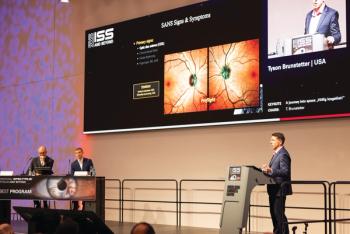
Insert improves symptoms and quality of life for patients with dry eye
The use of hydroxypropyl cellulose can significantly improve the symptoms of dry eye, resulting in increased quality of life.
The use of a proprietary hydroxypropyl cellulose ophthalmic insert (Lacrisert, Aton Pharma) significantly improved the symptoms of dry eye syndrome, resulting in an increased quality of life in patients with dry eye, according to the results of a recent study, which were presented by Bruce H. Koffler, MD, during the Association for Research in Vision and Ophthalmology annual meeting.
Artificial tears may be sufficient in treating mild symptoms of dry eye, but they can prove largely ineffective for moderate to severe disease, requiring more effective therapeutic measures, he said. The novel ophthalmic insert stabilizes the pre-corneal tear film and prolongs tear film break-up time, often accelerated in patients with dry eye, he added.
In a recent multicentre, two-visit, open-label, 4-week study, the acceptability and ease of use of the device was evaluated in 520 patients with a history of moderate to severe dry eye. At baseline, patients were given a general dry eye evaluation, screened by slit-lamp biomicroscopy and for best-corrected visual acuity, and required to fill out a questionnaire to complete the ocular surface disease index (OSDI).
Study participants were allowed to continue treatment with their dry eye regimens and additionally were given therapy with the insert. Patients were instructed on the proper insertion and use of the device and were contacted by telephone on day 3 of the study for follow-up, he said.
At visit two (week 4), patients were clinically evaluated and were required to complete a second questionnaire that evaluated perceived symptoms and changes in quality of life as a result of treatment.
OSDI scores
Results showed that the mean OSDI total scores significantly improved by more than 25% (from 41.8 ± 22.38 at visit one to 32.9 ± 21.97 at visit two). Patients recorded significant improvements in the mean occurrence of discomfort in heated areas and when performing house work. Significant reductions in the mean severity of dry eye symptoms also were seen, including discomfort (24.9% reduction), burning (34.9%), dryness (41.9%), grittiness (29%), sensitivity to light (18.9%), and stinging (28.5%), Dr Koffler said.
"The results that we saw in terms of statistically significant improvement in dry eye symptoms were rather dramatic in consideration of the fact that these patients were already [taking] their regular dry eye therapy," he said. "They had substantial improvement from their baseline symptoms with the addition of [the insert] to their daily regimen."
According to Dr Koffler, most experts would agree that it is rather unusual to see a 21.3% improvement in OSDI scores from a baseline of 41 to a 32 or 33.
Advantages, disadvantages
Often, patients who experience moderate to severe dry eye will stop using their artificial tears regimen or use less of the tears throughout the day once they start using the insert, he said. Artificial tears can be an inconvenience for patients with dry eye, but the insert is "hassle-free" and very user-friendly, requiring a single insertion once a day, he said.
"One of the major advantages of [the device] over other leading products used for dry eye is that it is a once-a-day treatment," he said. "The 24-hour slow release that you get from the pellet allows a continuous and constant coating of the ocular surface, which provides relief to the patient throughout the day."
One disadvantage of the insert is that it can cause blurred vision, which occurred in 8.7% of the patients in the study and was a cause for study discontinuation, he said. In patients who experience blurry vision, Dr Koffler suggested use of the device at night rather than in the morning. Using this approach, he said, the insert could substantially coat the eye throughout the night, and when patients remove the bulk of the insert in the morning, they still would have enough residual hydroxypropyl cellulose to coat the ocular surface for a good portion of the rest of the day.
"Ophthalmologists and optometrists should become more aware of the beneficial therapeutic effects of [the device], particularly in patients with moderate to severe dry eye syndrome," Dr Koffler said. "After they start using and working with it, I believe they will find it to be very useful in a significant percentage of their patients with dry eye."
Newsletter
Get the essential updates shaping the future of pharma manufacturing and compliance—subscribe today to Pharmaceutical Technology and never miss a breakthrough.




